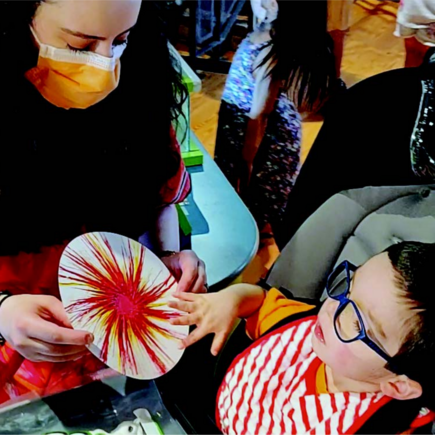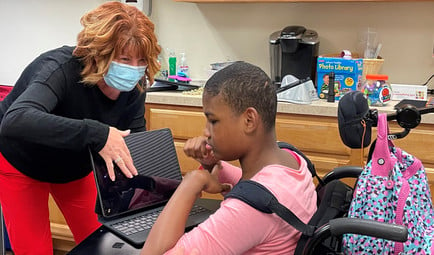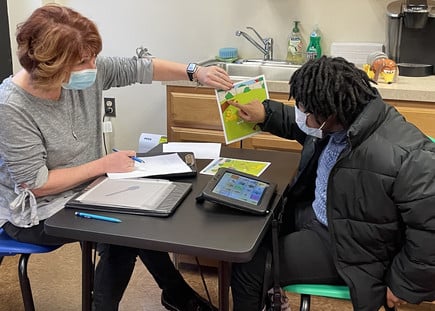What is CVI?
Cerebral Visual Impairment (CVI), also known as Cortical Visual Impairment or Central Visual Impairment, is a neurological visual impairment (NVI). It is a brain-based visual impairment -- meaning the cause involves the brain's complex visual system. CVI can be defined as visual loss resulting from damage to the visual pathways or visual processing centers of the brain (Roman-Lantzy, 2108). More simply, CVI is caused by damage to the parts of the brain that process vision. CVI occurs when the pathways or processing centers are damaged due to trauma or a medical event such as poor oxygen supply, illness, or medical condition. CVI can occur in conjunction with an ocular visual impairment. CVI is now considered the leading cause of pediatric visual impairment in industrialized nations.
Learn more about CVI
Cerebral Visual Impairment (CVI), also known as Cortical Visual Impairment or Central Visual Impairment, is defined as a visual impairment occurring as a result of the bilateral dysfunction of the optic radiation of the visual cortex, or both (Furze & Phillips, 2018). CVI can exist with ocular visual impairment and ocular motor disorder and can be the result of perinatal brain dysfunction, trauma, or injury (Roman-Lantzy, 2018). CVI is the leading cause of visual impairment in industrialized nations (Maitreya, Rawat & Pandey, 2018); yet the consequences of the impacts of the visual impairments are only beginning to be addressed (Lueck, Dutton, & Chokron, 2019). The prevalence of CVI has increased sharply, largely due to the increased survival rates of children who suffer neurological conditions in utero (Chokron & Dutton, 2016).
Making CVI more confusing to physicians, teachers, and parents, children with CVI vary in abilities. Some children with CVI are impacted by multiple health conditions, physical and learning disabilities. Othersmay be verbal and ambulatory but cannot consistently depend on their use of vision, especially in new or complex environments. Most have a normal or near-normal eye examination (Roman-Lantzy, 2018). For children who are neurologically stable and provided accessible materials and learning environments, improvement in their use of functional vision has been noted.(Handa, Saffari, & Borchert, 2018). While improvements in their use of vision can be achieved, young students with cerebral visual impairment never improve to normal vision (Maitreya, Rawat, & Pandey, 2018).
Teaching a child with CVI requires a completely different skill set than those skills learned to teach a child with an ocular visual impairment. Strategies designed for students with ocular visual impairments are not effective on those impacted by CVI (Martin, et al., 2016).
CVI Complete at Overbrook School for the Blind

CVI Complete, a collaboration between educators, medical professionals, researchers, and service providers to meet the increasing population statewide, nationally and internationally of children diagnosed with Cortical Visual Impairment (CVI), launched at Overbrook School for the Blind (OSB) in 2022 to meet the needs of children diagnosed or suspected to have CVI.
In addition to offering CVI assessments for enrolled students at OSB and for students from the community at large, CVI Complete offers high-quality training for educators and service providers, support and education for families, and supply opportunities to conduct research to contribute to the knowledge of CVI in the field. The assessments are offered on campus at no cost to families.
Additionally, CVI Complete offers CVI Parent Training Workshops to help families of children with CVI connect and collaborate with other parents and guardians who have children with CVI.
Meet Our CVI Specialist
Beth Ramella has been a Teacher of the Visually Impaired and Certified Orientation and Mobility Specialist for over 25 years. Dr. Ramella finished an Ed.D. in Educational Leadership. She completed a Master’s Degree in Special Education, a Teacher of Students with Visual Impairment (TVI) certification, and a Certified Orientation and Mobility Specialist (COMS) certificate from the University of Pittsburgh. She has a Special Education Supervision certification from Slippery Rock University and a Bachelor of Science in Elementary Education from Clarion University. Dr. Ramella is also currently working on a CVI research partnership with doctors from the Children’s Hospital of Pittsburgh Ophthalmology department. Dr. Ramella has had the opportunity to serve as a consultant at the American Printing House for the Blind and has helped to create new products for children who are cortically visually impaired. In her current role at OSB, Dr. Ramella conducts the CVI Range assessment with enrolled and non-enrolled students in the newly established CVI Complete Clinic. In her tenure, Dr. Ramella has been given many opportunities to build a rewarding career.
Frequently Asked Questions
What is CVI?
CVI is a neurological visual impairment (NVI) that affects how the brain processes vision.
What causes CVI?
There are many causes of CVI. Some of them include HIE, PVL, NAT, neonatal hypoglycemia, infections, metabolic disorders, antenatal drug use, cardiac arrest or anoxia, and twin gestation.
What are common characteristics?
Common characteristics can include: Color, need for movement, visual latency, visual field preferences, difficulties with visual complexity, need for light, atypical visual reflect responses, absence of visually guided reach, low vision, difficulty with distance, and difficulty with visual novelty.
Do children with CVI tend to have other disabilities or health problems?
Yes, some children with CVI also have other disabilities and health problems. Some of these include: developmental disabilities, cerebral palsy, epilepsy, and hearing loss.
How is CVI diagnosed?
There is no single test to diagnose for CVI, which can mean it might be difficult to receive a quick diagnosis. However, the first step every parent or guardian should take is to get a comprehensive eye exam to see if there is a problem with their child’s eyes. If that exam does not explain the symptoms your child is experiencing, that may be a sign that there is an issue concerning a neurological visual impairment. Find an ophthalmologist who is familiar with CVI. Specialists such as a neuro-ophthalmologist or pediatric neurologist may be helpful in the diagnosis.
What interventions are available?
All interventions must be individualized based on the child’s vision, strengths, needs, interests, and routines at home.
What resources can Overbrook School for the Blind (OSB) provide?
Currently, OSB offers no-cost assessments to families who expect their child may have CVI. A full narrative report is shared with the family, including review of educational plan and recommendations, following the assessment.
text
|







